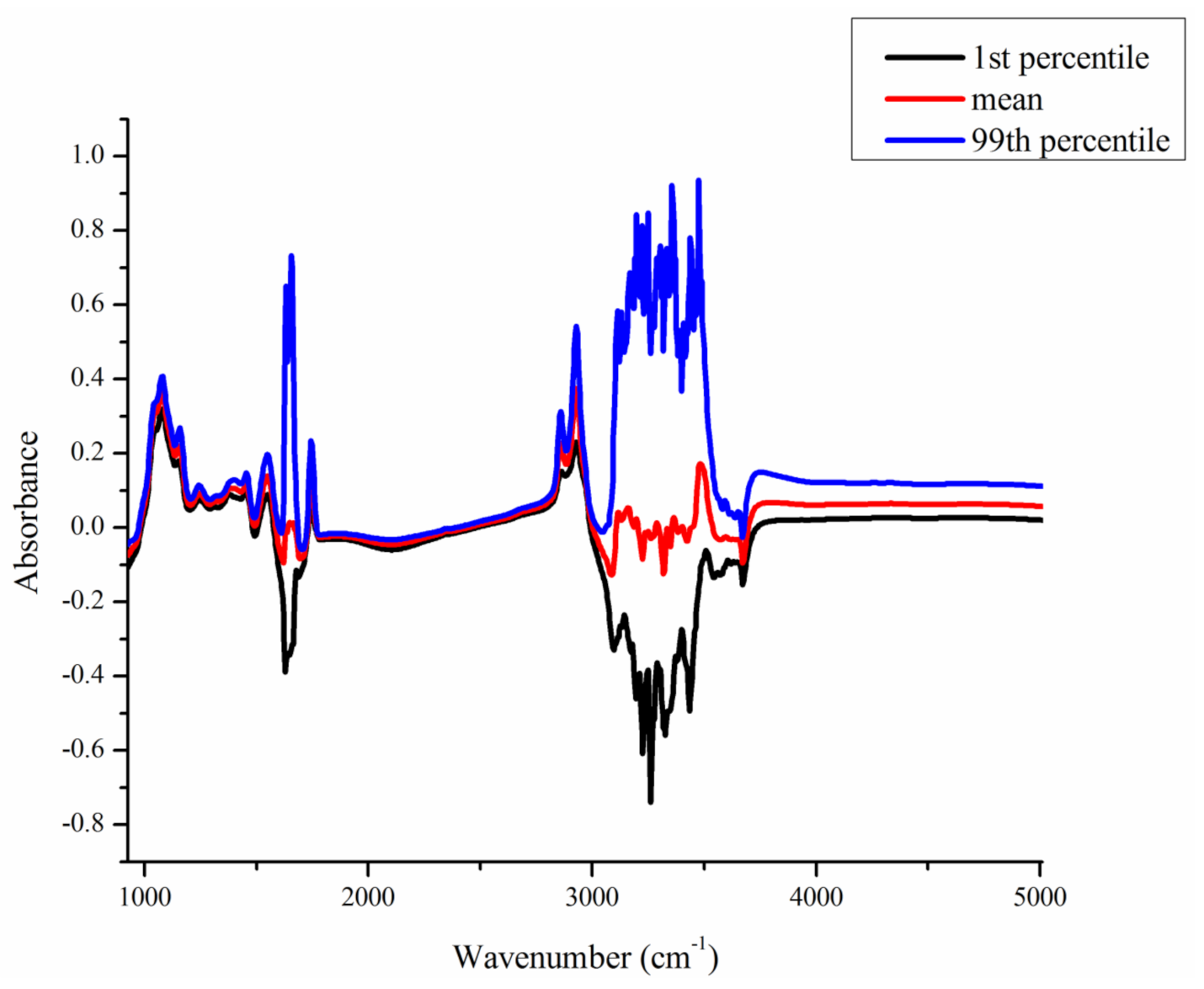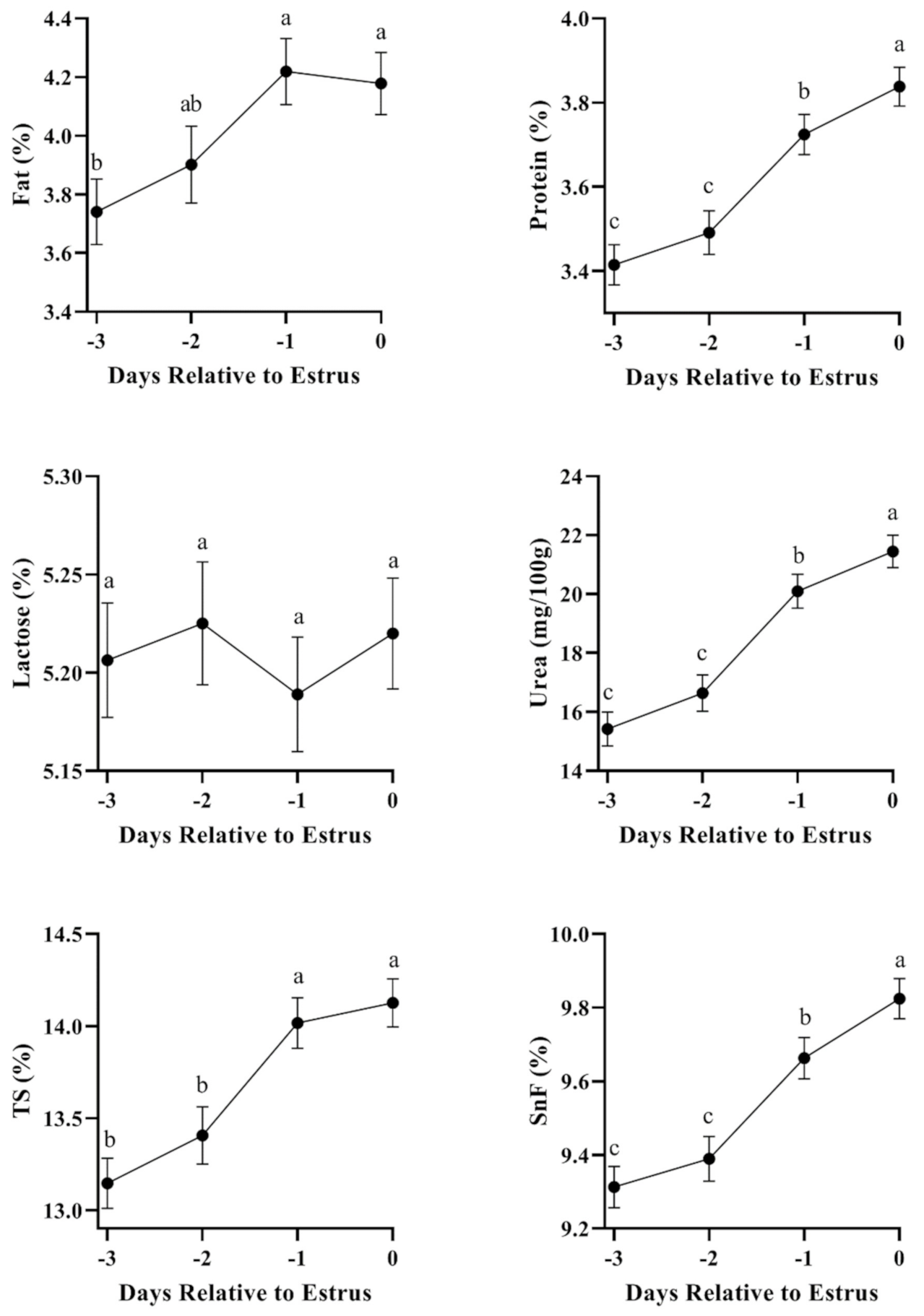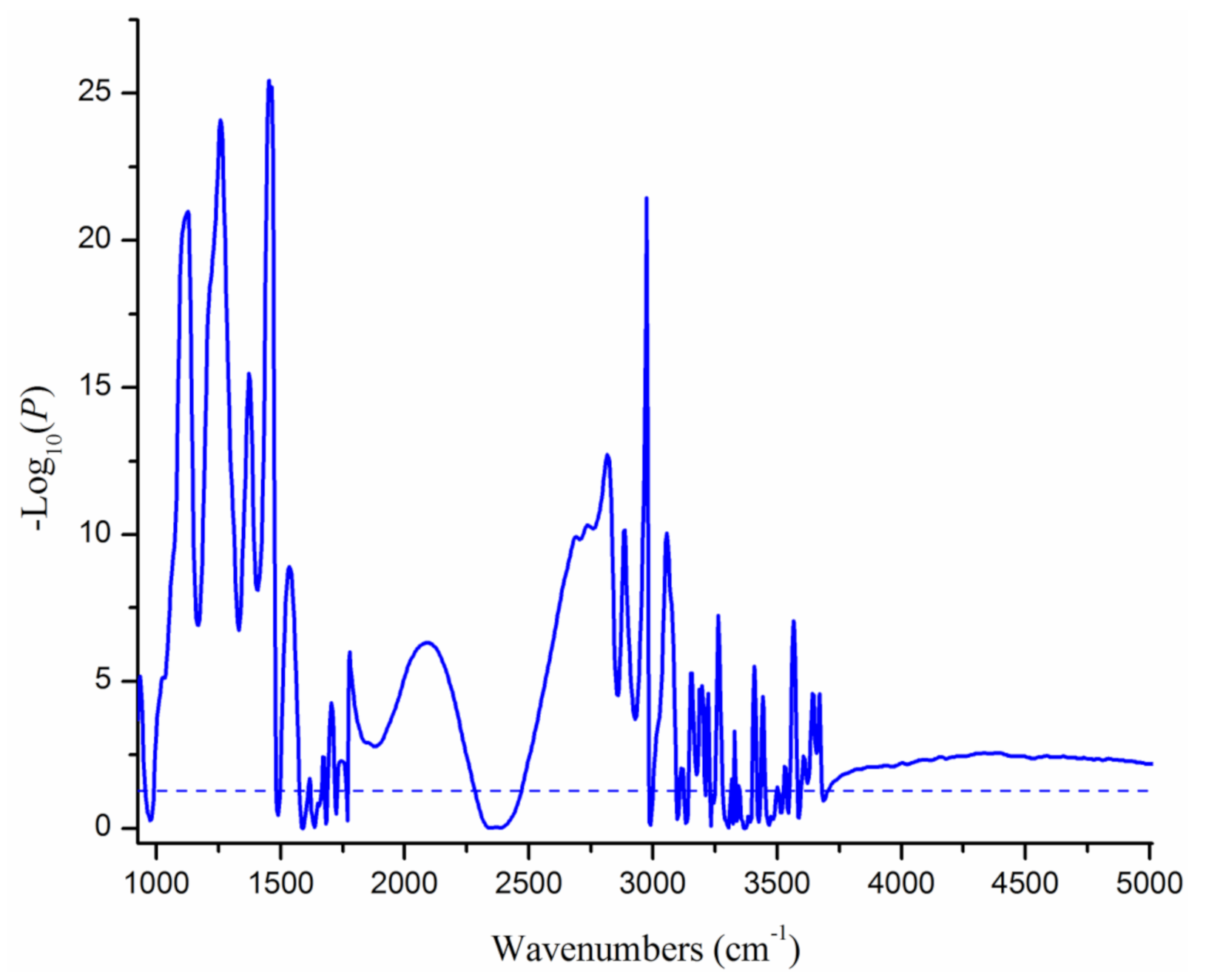Influence of Estrus on the Milk Characteristics and Mid-Infrared Spectra of Dairy Cows
Abstract
Simple Summary
Abstract
1. Introduction
2. Materials and Methods
2.1. Animal Management and Milk Samples
2.2. Milk Characteristics and MIR Spectral Data
2.3. Statistical Analysis
3. Results
3.1. Descriptive Statistics
3.2. Changes in the Milk Components and MIR Spectra
4. Discussion
5. Possible Use of Milk MIR Spectra in the Reproductive Management
6. Conclusions
Author Contributions
Funding
Institutional Review Board Statement
Informed Consent Statement
Data Availability Statement
Acknowledgments
Conflicts of Interest
References
- Palmer, M.A.; Olmos, G.; Boyle, L.A.; Mee, J.F. Estrus detection and estrus characteristics in housed and pastured Holstein–Friesian cows. Theriogenology 2010, 74, 255–264. [Google Scholar] [CrossRef] [PubMed]
- Reith, S.; Hoy, S. Review: Behavioral signs of estrus and the potential of fully automated systems for detection of estrus in dairy cattle. Animals 2018, 12, 398–407. [Google Scholar] [CrossRef] [PubMed]
- Saint-Dizier, M.; Chastant-Maillard, S. Towards an Automated Detection of Oestrus in Dairy Cattle. Reprod. Domest. Anim. 2012, 47, 1056–1061. [Google Scholar] [CrossRef]
- Talukder, S.; Kerrisk, K.; Ingenhoff, L.; Thomson, P.; Garcia, S.; Celi, P. Infrared technology for estrus detection and as a predictor of time of ovulation in dairy cows in a pasture-based system. Theriogenology 2014, 81, 925–935. [Google Scholar] [CrossRef] [PubMed]
- Leroy, C.; Walton, J.; Leblanc, S. Estrous detection intensity and accuracy and optimal timing of insemination with automated activity monitors for dairy cows. J. Dairy Sci. 2018, 101, 1638–1647. [Google Scholar] [CrossRef] [PubMed]
- Mayo, L.M.; Silvia, W.J.; Ray, D.L.; Jones, B.W.; Stone, A.E.; Tsai, I.C.; Clark, J.D.; Bewley, J.M.; Heersche, G., Jr. Automated estrous detection using multiple commercial precision dairy monitoring technologies in synchronized dairy cows. J. Dairy Sci. 2019, 102, 2645–2656. [Google Scholar] [CrossRef]
- Foroutan, A.; Guo, A.C.; Vazquez-Fresno, R.; Lipfert, M.; Zhang, L.; Zheng, J.; Badran, H.; Budinski, Z.; Mandal, R.; Ametaj, B.N.; et al. Chemical Composition of Commercial Cow’s Milk. J. Agric. Food Chem. 2019, 67, 4897–4914. [Google Scholar] [CrossRef]
- Alvarado, H.T.; Vazquez, A.I.; Campos, G.D.L.; Tempelman, R.J.; Gabai, G.; Cecchinato, A.; Bittante, G. Changes in milk characteristics and fatty acid profile during the estrous cycle in dairy cows. J. Dairy Sci. 2018, 101, 9135–9153. [Google Scholar] [CrossRef]
- Zebari, H.M.; Rutter, S.M.; Bleach, E.C. Fatty acid profile of milk for determining reproductive status in lactating Holstein Friesian cows. Anim. Reprod. Sci. 2019, 202, 26–34. [Google Scholar] [CrossRef]
- Zhao, C.; Bai, Y.; Fu, S.; Wu, L.; Xia, C.; Xu, C. Comparison of Metabolic Alterations in Serum and Milk Whey Between Inactive Ovaries and Estrus Dairy Cows. Front. Vet. Sci. 2021, 7, 609391. [Google Scholar] [CrossRef]
- Etzion, Y.; Linker, R.; Cogan, U.; Shmulevich, I. Determination of Protein Concentration in Raw Milk by Mid-Infrared Fourier Transform Infrared/Attenuated Total Reflectance Spectroscopy. J. Dairy Sci. 2004, 87, 2779–2788. [Google Scholar] [CrossRef]
- De Marchi, M.; Toffanin, V.; Cassandro, M.; Penasa, M. Invited review: Mid-infrared spectroscopy as phenotyping tool for milk traits. J. Dairy Sci. 2014, 97, 1171–1186. [Google Scholar] [CrossRef]
- Soyeurt, H.; Bastin, C.; Colinet, F.G.; Arnould, V.M.-R.; Berry, D.P.; Wall, E.; Dehareng, F.; Nguyen, H.N.; Dardenne, P.; Schefers, J.; et al. Mid-infrared prediction of lactoferrin content in bovine milk: Potential indicator of mastitis. Animals 2012, 6, 1830–1838. [Google Scholar] [CrossRef]
- Ferrand-Calmels, M.; Palhière, I.; Brochard, M.; Leray, O.; Astruc, J.; Aurel, M.; Barbey, S.; Bouvier, F.; Brunschwig, P.; Caillat, H.; et al. Prediction of fatty acid profiles in cow, ewe, and goat milk by mid-infrared spectrometry. J. Dairy Sci. 2014, 97, 17–35. [Google Scholar] [CrossRef]
- McDermott, A.; Visentin, G.; De Marchi, M.; Berry, D.; Fenelon, M.; O’Connor, P.; Kenny, O.; McParland, S. Prediction of individual milk proteins including free amino acids in bovine milk using mid-infrared spectroscopy and their correlations with milk processing characteristics. J. Dairy Sci. 2016, 99, 3171–3182. [Google Scholar] [CrossRef]
- Grelet, C.; Bastin, C.; Gelé, M.; Davière, J.-B.; Johan, M.; Werner, A.; Reding, R.; Pierna, J.F.; Colinet, F.; Dardenne, P.; et al. Development of Fourier transform mid-infrared calibrations to predict acetone, β-hydroxybutyrate, and citrate contents in bovine milk through a European dairy network. J. Dairy Sci. 2016, 99, 4816–4825. [Google Scholar] [CrossRef]
- Malacarne, M.; Visentin, G.; Summer, A.; Cassandro, M.; Penasa, M.; Bolzoni, G.; Zanardi, G.; De Marchi, M. Investigation on the effectiveness of mid-infrared spectroscopy to predict detailed mineral composition of bulk milk. J. Dairy Res. 2018, 85, 83–86. [Google Scholar] [CrossRef]
- Franzoi, M.; Niero, G.; Visentin, G.; Penasa, M.; Cassandro, M.; De Marchi, M. Variation of Detailed Protein Composition of Cow Milk Predicted from a Large Database of Mid-Infrared Spectra. Animals 2019, 9, 176. [Google Scholar] [CrossRef]
- Moroni, P.; Pisoni, G.; Savoini, G.; Van Lier, E.; Acuña, S.; Damián, J.; Meikle, A. Influence of Estrus of Dairy Goats on Somatic Cell Count, Milk Traits, and Sex Steroid Receptors in the Mammary Gland. J. Dairy Sci. 2007, 90, 790–797. [Google Scholar] [CrossRef]
- Akdag, F.; Cadirci, O.; Siriken, B. Effect of Estrus on Milk Yield and Composition in Jersey Cows. Bulg. J. Agric. Sci. 2010, 16, 783–787. [Google Scholar]
- Wang, Q.; Hulzebosch, A.; Bovenhuis, H. Genetic and environmental variation in bovine milk infrared spectra. J. Dairy Sci. 2016, 99, 6793–6803. [Google Scholar] [CrossRef] [PubMed]
- Du, C.; Nan, L.; Yan, L.; Bu, Q.; Ren, X.; Zhang, Z.; Sabek, A.; Zhang, S. Genetic Analysis of Milk Production Traits and Mid-Infrared Spectra in Chinese Holstein Population. Animals 2020, 10, 139. [Google Scholar] [CrossRef] [PubMed]
- De Marchi, M.; Fagan, C.; O’Donnell, C.; Cecchinato, A.; Zotto, R.D.; Cassandro, M.; Penasa, M.; Bittante, G. Prediction of coagulation properties, titratable acidity, and pH of bovine milk using mid-infrared spectroscopy. J. Dairy Sci. 2009, 92, 423–432. [Google Scholar] [CrossRef] [PubMed]
- Soyeurt, H.; Misztal, I.; Gengler, N. Genetic variability of milk components based on mid-infrared spectral data. J. Dairy Sci. 2010, 93, 1722–1728. [Google Scholar] [CrossRef]
- Bittante, G.; Cecchinato, A. Genetic analysis of the Fourier-transform infrared spectra of bovine milk with emphasis on individual wavelengths related to specific chemical bonds. J. Dairy Sci. 2013, 96, 5991–6006. [Google Scholar] [CrossRef]
- Zaalberg, R.; Shetty, N.; Janss, L.; Buitenhuis, A. Genetic analysis of Fourier transform infrared milk spectra in Danish Holstein and Danish Jersey. J. Dairy Sci. 2019, 102, 503–510. [Google Scholar] [CrossRef]
- Lainé, A.; Bastin, C.; Grelet, C.; Hammami, H.; Colinet, F.; Dale, L.; Gillon, A.; Vandenplas, J.; Dehareng, F.; Gengler, N. Assessing the effect of pregnancy stage on milk composition of dairy cows using mid-infrared spectra. J. Dairy Sci. 2017, 100, 2863–2876. [Google Scholar] [CrossRef]
- van Gastelen, S.; Dijkstra, J. Prediction of methane emission from lactating dairy cows using milk fatty acids and mid-infrared spectroscopy. J. Sci. Food Agric. 2016, 96, 3963–3968. [Google Scholar] [CrossRef]
- Dórea, J.; Rosa, G.; Weld, K.; Armentano, L. Mining data from milk infrared spectroscopy to improve feed intake predictions in lactating dairy cows. J. Dairy Sci. 2018, 101, 5878–5889. [Google Scholar] [CrossRef]
- Bonfatti, V.; Ho, P.; Pryce, J. Usefulness of milk mid-infrared spectroscopy for predicting lameness score in dairy cows. J. Dairy Sci. 2020, 103, 2534–2544. [Google Scholar] [CrossRef]
- Alvarado, H.T.; Vazquez, A.I.; Campos, G.D.L.; Tempelman, R.J.; Bittante, G.; Cecchinato, A. Diagnosing pregnancy status using infrared spectra and milk composition in dairy cows. J. Dairy Sci. 2018, 101, 2496–2505. [Google Scholar] [CrossRef]
- Delhez, P.; Ho, P.; Gengler, N.; Soyeurt, H.; Pryce, J. Diagnosing the pregnancy status of dairy cows: How useful is milk mid-infrared spectroscopy? J. Dairy Sci. 2020, 103, 3264–3274. [Google Scholar] [CrossRef]
- Ho, P.; Bonfatti, V.; Luke, T.; Pryce, J. Classifying the fertility of dairy cows using milk mid-infrared spectroscopy. J. Dairy Sci. 2019, 102, 10460–10470. [Google Scholar] [CrossRef]



| Trait | Mean | SD | CV | Min | Max |
|---|---|---|---|---|---|
| Fat (%) | 4.06 | 1.04 | 25.62 | 1.50 | 7.74 |
| Protein (%) | 3.68 | 0.51 | 13.86 | 2.37 | 5.36 |
| Lactose (%) | 5.21 | 0.26 | 4.99 | 2.14 | 5.72 |
| Urea (mg/100 g) | 18.81 | 5.86 | 31.15 | 5.80 | 33.90 |
| TS (%) | 13.81 | 1.34 | 9.70 | 7.78 | 17.60 |
| SnF (%) | 9.62 | 0.57 | 5.93 | 6.07 | 11.43 |
Publisher’s Note: MDPI stays neutral with regard to jurisdictional claims in published maps and institutional affiliations. |
© 2021 by the authors. Licensee MDPI, Basel, Switzerland. This article is an open access article distributed under the terms and conditions of the Creative Commons Attribution (CC BY) license (https://creativecommons.org/licenses/by/4.0/).
Share and Cite
Du, C.; Nan, L.; Li, C.; Sabek, A.; Wang, H.; Luo, X.; Su, J.; Hua, G.; Ma, Y.; Zhang, S. Influence of Estrus on the Milk Characteristics and Mid-Infrared Spectra of Dairy Cows. Animals 2021, 11, 1200. https://doi.org/10.3390/ani11051200
Du C, Nan L, Li C, Sabek A, Wang H, Luo X, Su J, Hua G, Ma Y, Zhang S. Influence of Estrus on the Milk Characteristics and Mid-Infrared Spectra of Dairy Cows. Animals. 2021; 11(5):1200. https://doi.org/10.3390/ani11051200
Chicago/Turabian StyleDu, Chao, Liangkang Nan, Chunfang Li, Ahmed Sabek, Haitong Wang, Xuelu Luo, Jundong Su, Guohua Hua, Yabing Ma, and Shujun Zhang. 2021. "Influence of Estrus on the Milk Characteristics and Mid-Infrared Spectra of Dairy Cows" Animals 11, no. 5: 1200. https://doi.org/10.3390/ani11051200
APA StyleDu, C., Nan, L., Li, C., Sabek, A., Wang, H., Luo, X., Su, J., Hua, G., Ma, Y., & Zhang, S. (2021). Influence of Estrus on the Milk Characteristics and Mid-Infrared Spectra of Dairy Cows. Animals, 11(5), 1200. https://doi.org/10.3390/ani11051200






